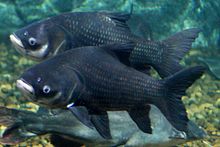Giant barb
| Giant barb | |
|---|---|

| |
| Scientific classification | |
| Kingdom: | |
| Phylum: | |
| Class: | |
| Order: | |
| Family: | |
| Genus: | Catlocarpio Boulenger, 1898
|
| Species: | C. siamensis
|
| Binomial name | |
| Catlocarpio siamensis Boulenger, 1898
| |
The giant barb or Siamese giant carp, Catlocarpio siamensis (Thai: กระโห้, RTGS: kraho, pronounced [krā.hôː], or กะมัน, RTGS: kaman, pronounced [kā.mān]; Khmer: ត្រីគល់រាំង, trei kól reăng), is the largest species of cyprinid in the world. These migratory fish are found only in the Mae Klong, Mekong and Chao Phraya river basins in Indochina. It has declined drastically due to habitat loss and overfishing, and it is now considered Critically Endangered.[1]
Distribution and habitat
They are usually seen in the big pools along the edges of large rivers, but will seasonally enter smaller canals, floodplains and flooded forests. Young barbs are usually found in smaller tributaries and swamps, but can acclimatize to living in ponds, canals and swamps.[2] The fish generally live in pairs.[3]
These are migratory fish, swimming to favorable areas for feeding and breeding in different parts of the year.[2] These slow-moving fish subsist on algae, phytoplankton and fruits of inundated terrestrial plants, rarely (if ever) feeding on active animals. In the lower Mekong basin, young giant barbs have been reported as occurring primarily in October.[2]
Physical characteristics

The head is rather large for the body. There are no barbels.[2]
The giant barb ranks among the largest freshwater fish in the world, and is probably the largest fish in the family Cyprinidae.[4] It may reach 3 m (9.8 ft) (although this claimed maximum length needs confirmation) and weigh up to 300 kg (660 lb).[2] Among the cyprinids, only the golden mahseer can reach a comparable length, but it is a relatively slender fish that weighs far less.[5] Few large giant barbs are caught today. For example, no individual weighing more than 150 kg (330 lb) has been caught in Cambodia since 1994.[1] Today the maximum length is about 1.8 m (6 ft).[citation needed]
This fish is actually tetraploid, meaning it has four of each chromosome (as opposed to diploid, the normal number in animals).[4]
Conservation status
Today, few barbs live to maturity. The main threats are from habitat loss (e.g., pollution and dams) and overfishing.[1] The sharp population decline is well illustrated by catch data from Cambodia, where 200 tonnes of giant barbs were caught in 1964. By 1980, only about 50 fish were caught and by 2000, only 10.[1] It was formerly an important fish in local catches below the Khone Phapheng Falls, but surveys between 1993 and 1999 only located a single small individual.[1] Consequently, the giant barb is listed as Critically Endangered on the IUCN Red List.[1] It has been entirely extirpated from the Chao Phraya River.[1]
In a 2005 royal decree, the Kingdom of Cambodia designated this fauna as the national fish to bring conservation awareness to this species.[6]
Notes
- ^ a b c d e f g h Template:IUCN2011.2
- ^ a b c d e Froese, Rainer; Pauly, Daniel (eds.) (2011). "Catlocarpio siamensis" in FishBase. August 2011 version.
- ^ Southeast Asia Rivers Network. "The Return of Fish, River Ecology and Local Livelihoods of the Mun River : A Thai Baan (Villagers') Research" n.p. November 2004. p. 59
- ^ a b Nelson, Joseph S. (2006). Fishes of the World. John Wiley & Sons, Inc. ISBN 0-471-25031-7
- ^ Froese, Rainer; Pauly, Daniel (eds.) (2012). "Tor putitora" in FishBase. January 2012 version.
- ^ ROYAL DECREE on Designation of Animals and Plants as National Symbols of the Kingdom of Cambodia


